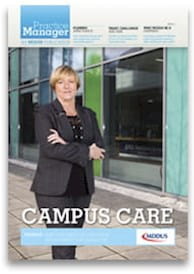NO practice system can be 100 per cent risk-free – be it one for following-up test results or for triaging patients. Even the most carefully designed systems can have ‘holes’ in them.
Most people familiar with concepts of risk will have come across the Swiss cheese model, first proposed by James Reason of the University of Manchester. Holes or gaps in a system can create windows of opportunity for errors to occur. In practice they are often picked up as near misses or recurring low-level failures. But when the holes align within a particular system and under particular circumstances there is the potential for catastrophic harm to occur.
To promote safe practice it is important to have mechanisms in place to control known risks and these must also extend to “softer” areas of practice such as team communication and interaction. Risks here might include difficulties around access to an appropriate clinician where multidisciplinary interactions are necessary (for example a receptionist facilitating access to the right clinician at the right time) or communication between healthcare professionals. This is particularly relevant where there is shared care and treatment by multiple clinicians over time.
Actions to mitigate such risks include building trust, facilitating challenge and ensuring that there is a level of comfort within the team’s interactions.
Trust and challenge
A strong factor influencing the way individuals communicate and work together is the level of trust present. Trust impacts on the willingness of individuals to challenge each other during team interactions. Healthy conflict and interpersonal challenge amongst individuals and groups is dependent on the level of trust they share and this can have real impact on day-to-day interactions and outcomes and, significantly, can create potential for increased risk.
Effective team interaction is essential in supporting risk reduction in systems of working, particularly where failures in service delivery are discussed, new processes are agreed and where the risks within clinical systems are reviewed. Problems can arise when key issues are not explored fully and honestly.
The connection between trust and risk – in particular how it can lead to poor team outcomes – has been widely demonstrated in other sectors. In his 2005 work on team functioning, management consultant and author Patrick Lencioni outlined five dysfunctions in teams which prevent them from achieving their goals. The main goal in the case of healthcare is to deliver a service through systems and working practices that support patient safety.
What makes a functional team?
Absence of trust and fear of conflict are the first two of Lencioni’s dysfunctions which, if unresolved, lead to poorer team working and outcomes. Lencioni argues that the foundation for a functional team is the ability to “trust each other on a fundamental, emotional level”. Team members must be comfortable exposing their weaknesses, mistakes, fears and behaviours to each other and to get to a point at which they can be completely open with one another without filters.
Lencioni believes this is essential because teams who trust each other are much more able to engage in healthy conflict, i.e. disagreeing with, challenging and questioning one another. These teams will achieve a better resolution to problems and more effective, safer and robust systems of working.
Where healthy conflict is present, the added benefit is that individuals are often more committed to decisions and feel (and can hold each other) accountable for them. This type of development within teams makes achieving their goals much more realistic. To attain this it is important to have a foundation of trust.
Within team meetings when difficult decisions have to be made around patient care, systems and use of resources, it is important that all critical points and views are up for discussion. Team members must trust that their points – particularly where they are different from those of the majority – will be listened to and respected and not ignored or ridiculed. Healthy conflict can then result in effective problem-solving and agreements that all individuals can own and buy into. Where this happens, individuals are less likely to violate agreed patient safety procedures or undermine decisions.
Symptoms and impacts
In team interactions where there is an absence of trust, it is likely that people will avoid conflict or challenging others. Telling symptoms of a lack of trust include:
• Critical and challenging points are not raised or incorporated into discussions.
• Individuals are more likely to conceal mistakes from one another.
• Individuals will hesitate to ask for help when they are struggling.
• Individuals are likely to dread approaching others for help for fear of rejection, ridicule or lack of support.
Such behaviours have a direct impact on risk. Commonly a lack of trust will mean that:
• Teams and individuals won’t have full situational awareness when making decisions about patient safety.
• Incident reports won’t be submitted and learning from mistakes will not occur.
• Individuals will choose (or feel forced) to work outside their boundaries or expertise because it is too hard to challenge others if they do not immediately offer support.
• Patients will not receive safe levels of care because support is not being asked for or provided.
Trust makes the difference in achieving healthy conflict and challenge which can really improve the way teams work and support risk reduction. Trust can also reduce the likelihood of negative conflict which can increase risk and threaten patient safety.
Building trust
One of the simplest ways to build trust is to create opportunities for individuals to get to know each other better. If people can understand their own and other people’s strengths and weaknesses – particularly in relation to communication and working preferences – they are more likely to be tolerant and understanding of their colleagues. Some organisations use formal behavioural profiling to do this – for example options such as DISC analysis or Myers-Briggs. These tools give team members an objective and reliable means for describing and understanding each other. In practical terms, this might mean a receptionist understands better how to approach a GP and present information in a way that is helpful to that individual’s preferences. This type of change in approach makes the communication process easier and more effective for all.
Other organisations arrange team building activities, create functional project groups across areas of work or support opportunities for social activities. In these activities, individuals can be encouraged to be more natural and equal with each other.
Developing clarity around roles, responsibilities and boundaries can also help build trust. This can be facilitated through teams examining shared systems through the different lenses associated with different roles. Highlighting the importance of each role serves to identify gaps or misinterpretations in a more objective way, this in itself working towards risk reduction.
So to reduce the potential for unacceptable clinical risk, it is important for teams to openly explore the link between trust, healthy conflict and risk reduction – so they can agree comfortable ways of ensuring healthy conflict happens. This includes acceptance that conflict is natural and that building trust is beneficial to risk reduction.
Cherryl Adams is a risk adviser at MDDUS
For more on this topic MDDUS members can access our video module on Trust and challenge which can be found in the Risk Management section of our website.
This page was correct at the time of publication. Any guidance is intended as general guidance for members only. If you are a member and need specific advice relating to your own circumstances, please contact one of our advisers.
Read more from this issue of Practice Manager

Save this article
Save this article to a list of favourite articles which members can access in their account.
Save to library

